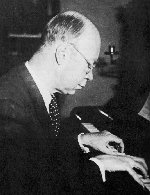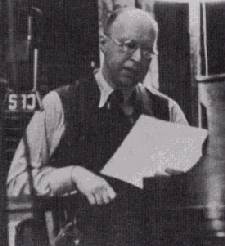Sergei Prokofiev (1891-1953)
(born Sontsovka, 23 April 1891; died Moscow, 5 March 1953).

He showed precocious talent as a pianist and composer and had lessons
from Glier from 1902. In 1904 he entered the St. Petersburg Conservatory,
where Rimsky-Korsakov, Lyadov and Tcherepnin
were among his teachers; Tcherepnin and Myaskovsky, who gave him valuable
support, encouraged his interest in Skryabin,
Debussy
and Strauss. He had made his début as
a pianist in 1908, quickly creating something of a sensation as an "enfant
terrible," unintelligible and ultra-modern - an image he was happy to cultivate.
His intemperateness in his early piano pieces, and later in such works
as the extravagantly Romantic
Piano Concerto no.1 and the ominous
no.2, attracted attention. Then in 1914 he left the conservatory
and travelled to London, where he heard Stravinsky's
works and gained a commission from Dyagilev:
the resulting score was, however, rejected (the music was used to make
the "Scythian Suite"); a second attempt, "Chout",
was not staged until 1921.
Meanwhile his gifts had exploded in several different directions. In
1917 he finished an opera on Dostoyevsky's
"Gambler," a violently involved study of obsession
far removed from the fantasy of his nearly contemporary Chicago opera "The
Love for Three Oranges," written in 1919 and performed in 1921.
Nor does either of these scores have much to do with his 'Classical'
Symphony, self-consciously 18th-century in manner, and again quite
distinct from his lyrical Violin Concerto no.1,
written at the same period and in the same key. There were also piano
sonatas based on old notebooks alongside the more adventurous "Visions
fugitives," all dating from 1915-19. Towards the end of this rich
period, in 1918, he left for the USA; then from 1920 France became his
base. His productivity slowed while he worked at his opera "The
Fiery Angel," an intense, symbolist fable of good and evil (it had
no complete performance until after his death, and he used much of its
music in Symphony no.3). After this he brought
the harsh, heavy and mechanistic elements in his
music to a climax in Symphony no.2 and
in the ballet
"Le pas d'acier," while his
next ballet, "L'enfant prodigue," is in a
much gentler style: the barbaric and the lyrical
were still alternatives in his music and not fused until the 1930s,
when he began a process of reconciliation with the Soviet Union.

The renewed relationship was at first tentative on both sides. "Romeo
and Juliet,"
the full-length ballet commissioned for the
Bol'shoy, had its premiere at Brno in 1938, and only later became
a staple of the Soviet repertory: its themes of aggression and romantic
love provided, as also did the Eisenstein film "Alexander
Nevsky," a receptacle for Prokofiev's divergent
impulses. Meanwhile his own impulse to remain a Westemer was gradually
eroded and in 1936 he settled in Moscow, where initially his concern was
with the relatively modest genres of song,
incidental music, patriotic
cantata and children's
entertainment ("Peter and the Wolf,"
1936). He had, indeed, arrived at a peculiarly unfortunate
time, when the drive towards socialist realism was at its most intense;
and his first work of a more ambitious sort, the opera
"Semyon Kotko" was not liked.
With the outbreak of war, however, he perhaps found the motivation to
respond to the required patriotism: implicitly in a cycle of three
piano sonatas (nos.6-8) and Symphony no.5,
more openly in his operatic setting of scenes from
Tolstoy's "War
and Peace," which again offered opportunities for the two extremes
of his musical genius to be expressed. He also worked at a new full-length
ballet,
"Cinderella."
In 1946 he retired to the country and though he went on composing, the
works of his last years have been regarded as a quiet coda to his output.
Even his death was outshone by that of Stalin on the same day.

